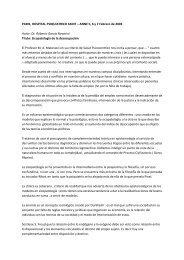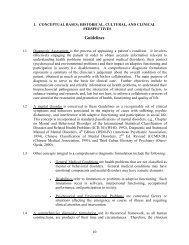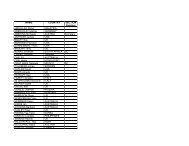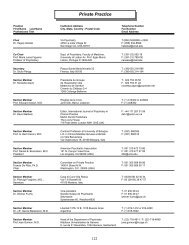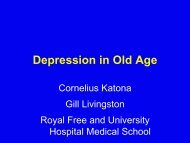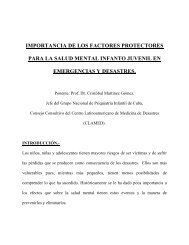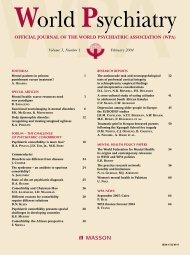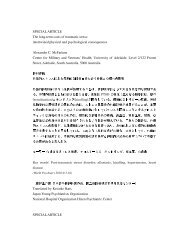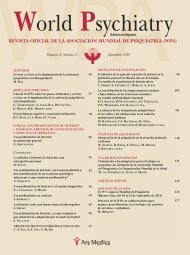ABSTRACTS - World Psychiatric Association
ABSTRACTS - World Psychiatric Association
ABSTRACTS - World Psychiatric Association
Create successful ePaper yourself
Turn your PDF publications into a flip-book with our unique Google optimized e-Paper software.
attempted suicides, primary outcome) with a decrease in Nuremberg<br />
(500,000 inhabitants) of 24% after two intervention years and a further<br />
decrease in the follow-up years. This concept and the intervention<br />
materials have been adopted and refined by many regions in 17<br />
countries within the European Alliance against Depression, funded<br />
by the European Commission.<br />
US11.<br />
BRAIN IMAGING IN PSYCHIATRY: RECENT<br />
PROGRESS AND CLINICAL IMPLICATIONS<br />
US11.1.<br />
ADVANCEMENTS IN MOLECULAR POSITRON<br />
EMISSION TOMOGRAPHY IMAGING<br />
FOR PSYCHIATRIC RESEARCH<br />
L. Farde<br />
Department of Clinical Neuroscience, Karolinska Institutet,<br />
Stockholm; AstraZeneca R&D, Södertalje, Sweden<br />
The imaging technology positron emission tomography (PET) is used<br />
to trace radiolabeled molecules in the human brain. Molecular imaging<br />
is based on the development of suitable radioligands for neuroreceptors,<br />
enzymes or transport proteins. The radioligand can then be<br />
used in research on the pathophysiology of brain disorders or in clinical<br />
pharmacology to measure the occupancy of drug treatments. A<br />
related approach is to develop radioligands that bind to biomarkers<br />
for pathophysiology, such as amyloid in Alzheimer’s disease. Work on<br />
new proteins is a particular challenge in neuroscience, because<br />
approximately half of the human genes are expressed in brain. This<br />
availability of numerous new proteins provides vast opportunities for<br />
new drug treatment. However, using the suitable radioligands so far<br />
developed for molecular imaging, only about 25 central nervous system<br />
proteins can be examined by PET. The field benefits from the<br />
present industrial investments in PET imaging and access to chemistry<br />
resources, which facilitates more effective developments of new radioligands.<br />
Interestingly, these efforts may in addition provide academia<br />
with new tools to reveal the functional role of recently discovered proteins<br />
in the human brain. Such research benefits from the advancements<br />
of the PET technology. The high resolution research tomography<br />
(HRRT) and recent implementation of improved image reconstruction<br />
software provides brain imaging at a resolution of about 1.6<br />
mm. This high resolution allows for detailed mapping of proteins and<br />
disease biomarkers in the human brain. Moreover, advanced image<br />
analysis, including statistical methods for recognition of patterns of<br />
protein distribution in brain, are now developed to take benefit of the<br />
vast amount of information generated by a single PET measurement.<br />
Taken together, these methodological advancements pave the way for<br />
a new era of PET imaging in psychiatric research.<br />
US11.2.<br />
ADVANCES IN WHITE MATTER IMAGING<br />
AND THEIR APPLICATION TO SCHIZOPHRENIA<br />
M.E. Shenton, M. Kubicki, T. Kawashima, D. Markant, T. Ngo,<br />
R.W. McCarley, C.-F. Westin<br />
Departments of Psychiatry and Radiology, Brigham and Women’s<br />
Hospital and Harvard Medical School, Boston, MA; Department<br />
of Psychiatry, Veterans Affairs Boston Healthcare System<br />
and Harvard Medical School, Brockton, MA, USA<br />
While a great deal of progress has been made over the last two decades<br />
in identifying gray matter abnormalities in schizophrenia, only recently<br />
has the same level of scrutiny been applied to white matter. Moreover,<br />
recent longitudinal magnetic resonance imaging (MRI) studies<br />
demonstrate progressive changes in gray matter in both temporal and<br />
frontal cortices, following illness onset. In contrast, far less is known<br />
about the evolution and progression of white matter abnormalities, or<br />
about the integrity of white matter connections, particularly those that<br />
connect the frontal and temporal lobes, tracts that have long been<br />
thought to be abnormal in schizophrenia. With the development of<br />
diffusion tensor imaging, we are now able to investigate white matter<br />
abnormalities. Here, we report recent findings using region of interest<br />
and tractography methods that show fronto-temporal abnormalities<br />
in chronic schizophrenia, including uncinate fasciculus, fornix, and<br />
cingulum bundle. We also present findings in schizotypal personality<br />
disorder (SPD), first episode patients diagnosed with schizophrenia<br />
(FESZ), and first episode patients diagnosed with bipolar disorder<br />
with psychotic features (FEBP). For SPD and first episode patients,<br />
we report uncinate but not cingulum bundle abnormalities. These<br />
findings suggest that cingulum bundle abnormalities are not present in<br />
SPD or at first episode, but are evident in chronic schizophrenia. In<br />
addition, findings suggest that uncinate fasciculus abnormalities may<br />
not specific to schizophrenia or to SPD, as they are evident in FEBP<br />
and FESZ. Further studies are needed that follow changes over time<br />
in order to further characterize white matter abnormalities in schizophrenia<br />
and bipolar disorder.<br />
US11.3.<br />
NEUROIMAGING IN PSYCHOSIS: INTEGRATION<br />
OF DATA ACROSS MODALITIES<br />
P. McGuire<br />
Institute of Psychiatry and OASIS, London, UK<br />
Recent neuroimaging studies have provided new information about<br />
the mechanisms underlying the development of psychosis. Volumetric<br />
magnetic resonance imaging (MRI) and diffusion tensor imaging<br />
(DTI) studies have clarified the extent to which grey and white matter<br />
abnormalities are evident before and after the onset of psychosis,<br />
while the application of functional MRI (fMRI) has indicated the<br />
neural basis of impaired executive functions, memory and salience<br />
processing in the early phase of the disorder. Similarly, studies using<br />
positron emission tomography (PET) and MR spectroscopy have<br />
revealed how dopamine and glutamate transmission are altered in the<br />
prodromal phase of psychosis. However, these studies have been conducted<br />
separately, and the relationship between the structural, functional<br />
and neurochemical findings they have identified is unclear.<br />
Using different neuroimaging techniques in the same subjects provides<br />
a means of addressing this issue. We have employed this<br />
approach in subjects with prodromal signs of psychosis. In a study<br />
combining F-dopa PET with fMRI, there was a significant correlation<br />
between elevated striatal dopamine function in prodromal subjects<br />
and altered prefrontal activation during a verbal fluency task. In a<br />
second study that combined volumetric MRI and MR spectroscopy,<br />
reduced medial temporal and prefrontal grey matter volume in prodromal<br />
subjects was correlated with the degree to which glutamate<br />
levels in the thalamus were reduced. These initial results suggest that,<br />
although logistically difficult, multi-modal neuroimaging has the<br />
potential to advance our understanding of the pathophysiology of<br />
psychiatric disorders.<br />
15




